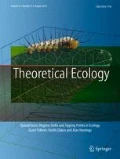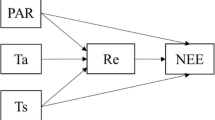Abstract
The dynamic aspects of human harvesting behaviour are often overlooked in resource management, such that models often neglect the complexities of dynamic human effort. Some researchers have recognized this, and a recent push has been made to understand how human behaviour and ecological systems interact through dynamic social-ecological systems. Here, we use a recent example of a social-ecological dynamical systems model to investigate the relationship between harvesting behaviour and the dynamics and stability of a harvested resource, and search for general rules in how relatively simple human behaviours can either stabilize or destabilize resource dynamics and yield. Our results suggest that weak to moderate behavioural and effort responses tend to stabilize dynamics by decreasing return times to equilibria or reducing the magnitude of cycles; however, relatively strong human impacts can readily lead to human-driven cycles, chaos, long transients and alternate states. Importantly, we further show that human-driven cycles are characteristically different from typical resource-driven cycles and, therefore, may be differentiated in real ecosystems. Given the potentially dramatic implications of harvesting on resource dynamics, it becomes critical to better understand how human behaviour determines harvesting effort through dynamic social-ecological systems.






Similar content being viewed by others
References
Anderson CNK, Hsieh C, Sandin SA, Hewitt R, Hollowed A, Beddington J, May RM, Sugihara G (2008) Why fishing magnifies fluctuations in fish abundance. Nature 452:835–839
Bascompte J, Melián CJ, Sala E (2005) Interaction strength combinations and the overfishing. Proc Natl Acad Sci U S A 102(15):5443–5447
Berlow EL, Neutel A-M, Cohen JE, de Ruiter PC, Ebenman B, Emmerson M, Fox JW et al (2004) Interaction strengths in food webs. J Anim Ecol 73:585–598
Boettiger C, Hastings A (2012) Quantifying limits to detection of early warning for critical transitions. J R Soc Interface 9(75):2527–2539
De Ruiter PC, Neutel A-M, Moore JC (1995) Energetics, patterns of interaction strengths, and stability in real ecosystems. Science 269(5228):1257–1260
Estes JA, Terborgh J, Brashares JS, Power ME, Berger J, Bond WJ, Carpenter SR et al (2011) Trophic downgrading of planet earth. Science 333:301–307
Fryxell JM, Packer C, McCann KS, Solberg EJ, Saether B-E (2010) Resource management cycles and the sustainability of harvested wildlife populations. Science 328:903–906
Fulton EA, Smith ADM, Smith DC, van Putten IE (2011) Human behaviour: the key source of uncertainty in fisheries management. Fish Fish 12:2–17
Gellner G, McCann KS (2016) Consistent role of weak and strong interactions in high- and low-diversity trophic food webs. Nat Commun 7(11180):8pp
Gellner G, McCann KS, and Hastings A. 2016. The duality of stability: towards a stochastic theory of species interactions. Theoretical Ecology, pp 9
Gilbert B, Tunney TD, McCann KS, DeLong JP, Vasseur DA, Savage V, Shurin JB et al (2014) A bioenergetic framework for the temperature dependence of trophic interactions. Ecol Lett 17(8):902–914
Guckenheimer J, Holmes PJ (1983) Nonlinear oscillations, dynamical systems, and bifurcations of vector fields. Springer, New York
Hone ANW, Irle MV, Thurura GW (2010) On the Neimark-Sacker bifurcation in a discrete predator-prey system. J Biol Dyn 4(6):594–606
Horan RD, Fenichel EP, Drury KLS, Lodge DM (2011) Managing ecological thresholds in coupled environmental-human systems. Proc Natl Acad Sci 108(18):7333–7338
Hsieh C-H, Reiss CS, Hunter JR, Beddington JR, May RM, Sugihara G (2006) Fishing elevates variability in the abundance of exploited species. Nature 443:859–862
Lade SJ, Tavoni A, Levin SA, Schlüter M (2013) Regime shifts in a social-ecological system. Theor Ecol 6(3):359–372
Lade SJ, Niiranen S, Hentati-Sundberh J, Blencker T, Boonstra WJ, Orach K, Quaas MF, Österblom H, Schlüter M (2015) An empirical model of the Blatic Sea reveals the importance of social dynamics for ecological regime shifts. Proc Natl Acad Sci 112(35):11120–11125
May RM, Oster GF (1976) Bifurcations and dynamic complexity in simple ecological models. Am Nat 110(974):573–599
McCann KS. 2011. Food webs (MPB-50), Princeton University Press
McCann KS, Yodzis P (1994) Nonlinear dynamics and population disappearances. Am Nat 144(5):873–879
McCann KS, Hastings A, Huxel GR (1998) Weak trophic interactions and the balance of nature. Nature 395(6704):794–798
McCann KS, Gellner G, McMeans BC, Deenik T, Holtgrieve G, Rooney N, Hannah L, Cooperman M, So N (2016) Food webs and the sustainability of indiscriminate fisheries. Can J Fish Aquat Sci 73:656–665
Milner-Gulland EJ (2011) Integrating fisheries approaches and household utility models for improved resource management. Proc Natl Acad Sci 108(4):1741–1746
Murdoch WW, Briggs CL, and Nisbet RM. 2003. Consumer-resource dynamics (MPB-36), Princeton University Press
Nilsson KA, McCann KS (2016) Interaction strength revisited—clarifying the role of energy flux for food web stability. Theor Ecol 9(1):59–71
Ostrom E (2009) A general framework for analyzing sustainability of social-ecological systems. Science 325:419–422
Ricker WE (1954) Stock and recruitment. Journal of the Fisheries Board of Canada 11(5):559–623
Rosenzweig ML (1971) Paradox of enrichment: destabilization of exploitation ecosystems in ecological time. Science 171(3969):385–387
Salas S, Gaertner D (2004) The behavioural dynamics of fishers: management implications. Fish Fish 5:153–167
Schlüter M, McAllister RRJ, Arlinghaus R, Bunnefeld N, Eisenack K, Hölker F, Milner-Gulland EJ et al (2012) New horizons for managing the environment: a review of coupled social-ecological systems modeling. Nat Resour Model 25(1):219–272
Schlüter M, Tavoni A, Levin S (2016) Robustness of norm-driven cooperation in the commons. Proc R Soc B 283:20152431
Schreiber SJ (2003) Allee effects, extinctions, and chaotic transients in simple population models. Theor Popul Biol 64:201–209
Shelton AO, Mangel M (2011) Fluctuations of fish populations and the magnifying effects of fishing. Proc Natl Acad Sci 108(17):7075–7080
Strogatz SH. 2014. Nonlinear dynamics and chaos: with applications to physics, biology, chemistry, and engineering, Westview Press
Tavoni A, Schlüter M, Levin S (2012) The survival of the conformist: social pressure and renewable resource management. J Theor Biol 299:152–161
Travis J, Coleman FC, Auster PJ, Cury PM, Estes JA, Orensanz J, Peterson CH, Power ME, Steneck RS, Wootton JT (2014) Integrating the invisible fabric of nature into fisheries management. Proc Natl Acad Sci 111(2):581–584
Turchin P. 2003. Complex population dynamics: a theoretical/empirical synthesis, Princeton University Press
Whipple SJ, Link JS, Garrison LP, Fogarty MJ (2000) Models of predation and fishing mortality in aquatic ecosystems. Fish Fish 1(1):22–40
Acknowledgements
This research was funded by Belmont Freshwater Security and NSERC Discovery grants to KSM. This paper is also a contribution to the Food from Thought research program supported by the Canada First Research Excellence Fund. We would like to thank three anonymous reviewers whose comments and suggestions helped to improve the manuscript.
Author information
Authors and Affiliations
Corresponding author
Electronic supplementary material
ESM 1
(DOCX 959 kb)
Rights and permissions
About this article
Cite this article
Bieg, C., McCann, K.S. & Fryxell, J.M. The dynamical implications of human behaviour on a social-ecological harvesting model. Theor Ecol 10, 341–354 (2017). https://doi.org/10.1007/s12080-017-0334-3
Received:
Accepted:
Published:
Issue Date:
DOI: https://doi.org/10.1007/s12080-017-0334-3




